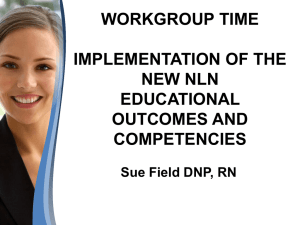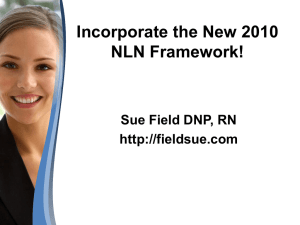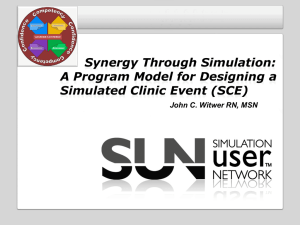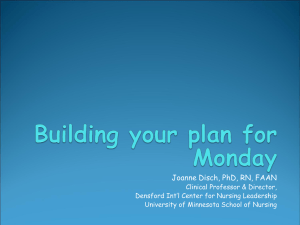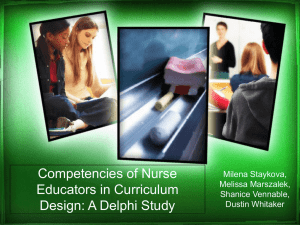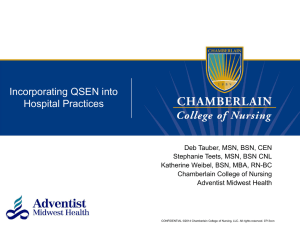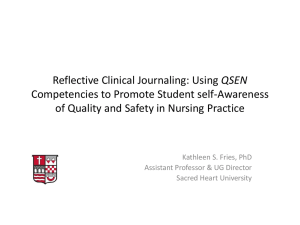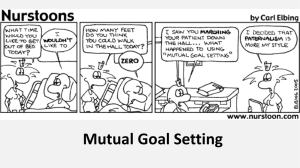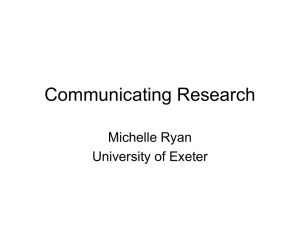Incorporating NLN Framework into your Nursing
advertisement
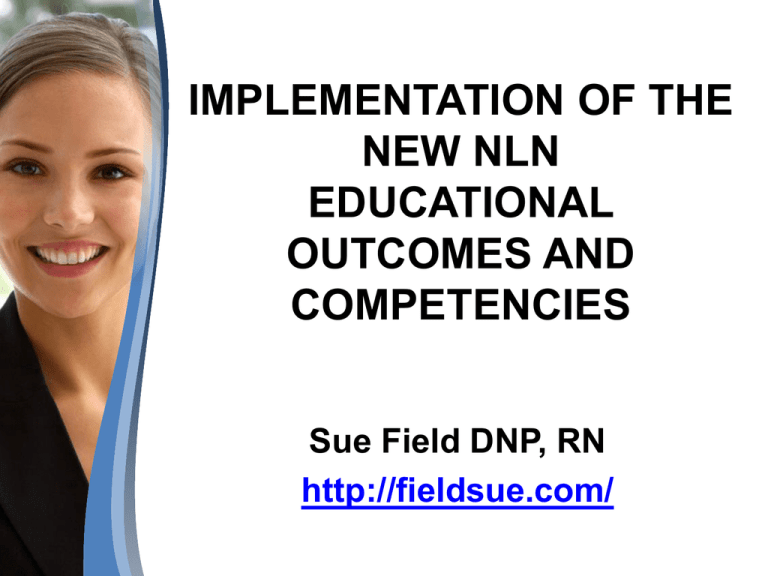
IMPLEMENTATION OF THE NEW NLN EDUCATIONAL OUTCOMES AND COMPETENCIES Sue Field DNP, RN http://fieldsue.com/ Journey to a Template • NLNAC – Initial Accreditation 2010 – Less than desirable framework for curriculum • Introduced to NLN framework • Templates developed Fall 2010/Spring 2011 • Presented Templates Fall 2011 NLN Conference • Faculty Consultants • June Larson, MS, RN, CNE, ANEF – Chair of the NLN Nursing Education Advisory Council Competency Work Group – University of South Dakota • Denise Hirst, MSN, RN – QSEN Project Manager/Clinical Assistant Professor – University of North Carolina –Chapel Hill NLN Framework Objectives: Attendees will develop skills to 1. Contrast student learner outcomes of the NLN framework to their program’s student learner outcomes 2. Identify a resource to integrate the core values of the NLN Educational Competencies Model into nursing programs. Objectives continued… 3. Demonstrate skills to implement the integrating concepts of the NLN Educational Competencies Model into nursing programs. 4. Evaluate course objectives which reflect the three apprenticeships of the integrating concepts of the NLN framework. Objectives continued… 5. Identify a method to facilitate faculty group involvement in the implementation of the NLN framework. Purchase • National League for Nursing. (2010). Outcomes and competencies for graduates of practical/vocational, associate degree, baccalaureate, master’s, practice doctorate, and research doctorate programs in nursing. NLN. • http://www.nln.org/facultydevelop ment/competencies/index.htm Background Nationally • Institute of Medicine (IOM) – Multiple reports (To Err is Human, 1996, 1999) – 2001, 2003, 2004, 2006 • Carnegie Study: – Educating Nurses a Call for Radical Transformation: Benner, Sutphen, Leonard & Day (2010) • QSEN 2005-Present – 5 competencies from the IOM + Safety • NLN Outcomes and Competency Framework – 2010 AHRQ: Susan Sheridan Story • Agency of Healthcare Research and Quality (AHRQ) – http://www.ahrq.gov/video/teamsteppstools/ts_Sue_S heridan/Sue_Sheridan-400-300.html Systems Approach • Systems thinking: – Inputs: Core Values – Throughputs: Integrating Concepts – Outputs: Program Learner Outcomes 1. Inputs = The Core Values • NLN Core Values – Caring, Diversity, Integrity and Excellence • NLN Workgroup Added – Ethics, Patient Centeredness, and Holism 1. Inputs = The Core Values • Present in your Philosophy Statement – Flow through your Curriculum • Flow to your Program Learner Outcomes Core Values Template Example 2. Throughputs = Integrating Concepts 6 Integrating Concepts 1. Context and Environment 2. Knowledge and Science 3. Personal/Professional Development 4. Quality and Safety 5. Relationship Centered Care 6. Teamwork Integrating Concept Context and Environment – – – – – – – – Policies, procedures Rewards, supervision Organizational structure Leadership styles Patient characteristics Safety and ethical climate Teamwork Continuous quality improvement Clinical Setting • Context and Environment Integrating Concept Knowledge and Science • Integration of knowledge from – the sciences – social sciences – arts and humanities • Along with the – science of nursing – evidence based practice Integrating Concept Personal/Professional Development • A lifelong process – of learning and refining – integrating values and behaviors • Gives nurses courage – to continually improve – care of patients, families, and communities • Ensure profession's ongoing viability Integrating Concept Quality and Safety • Minimize the risk of harm to – individuals – populations – providers • Increase the likelihood of desired health outcomes Integrating Concept Relationship Centered Care • Caring, therapeutic relationships – patients, families and communities – and professional relationships • Respect for the dignity and uniqueness of others Integrating Concept Teamwork • Function effectively – within nursing and – Inter-professional teams • Fostering open communication – mutual respect – shared decision making – quality patient care Apprenticeships QSEN NLN Knowledge Skills Attitudes Knowledge Practice ‘Know How’ Ethical Comportment Cronenwett et al., 2007 Benner et al., 2009 Three Apprenticeships Integrating Concepts Three Apprenticeships 1. Context and Environment – – – Knowledge Practice Know How Ethical Comportment 2. Knowledge and Science – – – Knowledge Practice Know How Ethical Comportment 3. Personal/Professional Development – – – Knowledge Practice Know How Ethical Comportment 4. Quality and Safety – – – Knowledge Practice Know How Ethical Comportment 5. Relationship Centered Care – – – Knowledge Practice Know How Ethical Comportment 6. Teamwork – – – Knowledge Practice Know How Ethical Comportment Integrating Concepts Template Example 3. Program Learner Outcomes 1. 2. 3. 4. Human Flourishing Nursing Judgment Professional Identify Spirit of Inquiry Program Competencies PN to BSN Professional Identity PRACTICAL/ VOCATIONAL ASSOCIATE DEGREE/ DIPLOMA Assess how one’s Implement one’s role as a personal strengths and nurse in ways that reflect values affect one’s integrity, responsibility, identity as a nurse and ethical practices, and an one’s contributions as evolving identity as a nurse a member of the committed to evidencehealth care team. based practice, caring, advocacy, and safe, quality care for diverse patients within a family and community context. BACCALAUREATE Express one’s identity as a nurse through actions that reflect integrity; a commitment to evidencebased practice, caring, advocacy, and safe, quality care for diverse patients, families, and communities; and a willingness to provide leadership in improving care. Program Competencies MS to DNP Professional Identity MASTER’S Implement one’s advanced practice role in ways that foster best practices, promote the personal and professional growth of oneself and others, demonstrate leadership, promote positive change in people and systems, and advance the profession. PRACTICE DOCTORATE RESEARCH DOCTORATE As a nurse-scholar, seek Implement one’s role as a ways to translate research research scholar findings into practice, and committed to a spirit of help design and implement inquiry, the systematic changes in nursing practice investigation of nursingand health policy that will related problems, and the best serve a diverse dissemination of research population and a diverse findings, in a manner nursing workforce. informed by a sense of responsibility to shape a preferred future for our profession. Program Learner Outcomes Template 1 Program Learner Outcomes Template 2 QSEN and NLN Competencies and Outcomes QSEN • • • • • • Patient Centered Care • Safety • Informatics • Teamwork and Collaboration • Quality Improvement Evidence Based Practice NLN Human Flourishing Nursing Judgment Personal/Professional identity Spirit of Inquiry QSEN and NLN Comparison QSEN • Patient Centered Care – Specifics about pain and suffering NLN • Learner Outcomes – Human Flourishing • Integrating Concept – Relationship Centered Care • Core Values – Patient Centered Care QSEN and NLN Comparison QSEN • Teamwork and Collaboration NLN • Learner Outcome – Personal/Professional Identify • Much more included in NLN • Integrating Concept – Teamwork QSEN and NLN Comparison QSEN • Safety • Quality Improvement NLN • Program Learner Outcome – Spirit of Inquiry • Integrating Concept – Quality and Safety • Core Value – Excellence QSEN and NLN Comparison QSEN • Evidence Based Practice NLN • Program Learner Outcomes – Spirit of Inquiry – Nursing Judgment • Integrating Concepts – Knowledge and Science QSEN and NLN Comparison QSEN • Informatics NLN • Integrating Concepts – Context and Environment • Much more covered under the NLN NLN Differences • Integrating Concepts – Personal/Professional Development • • • • • • Creativity and problem identification Non linear problem solving Codes of Ethics and Professional Standards Take risks Impact of continual knowledge explosion Difference between leadership and management NLN Differences • Context and Environment – – – – – – – Change, complexity, uncertainly Ethics, values, beliefs Code of ethics, ANA, HIPAA Health promotion/prevention of disease 6 principles of a healthy work environment Clinical and financial systems Creativity, non linear problem solving QSEN • More specific in – Quality Improvement Apprenticeships – Patient Centered Care • Pain and Suffering specifically NLN Outcomes and Competency Framework Model – Framework Complete • Incorporates QSEN – Incorporates National Standards » Research Based • Up to date as of 2010! • Curriculum is continually changing! – QSEN and NLN Crosswalk “How To’s” Steps that might work for you and your nursing program How to: Part I • PAIR faculty members – Who teach the same courses • Determine for each course outcome – How the course outcome relates to the program outcomes – Determine the learning activities for the outcome and – Determine the measurements used for the outcome • See template next slide How to: Part I Course Template How to: Part II Round Robin • Arrange tables by integrating concepts – Attach template to tables by integrating concepts • Faculty pairs rotate through the stations. – Faculty identify the course outcomes that fulfill competencies listed Context and Environment Relationship Centered Care 3 Apprenticeships for each: Knowledge and Science Knowledge Practice Ethical Comportment Teamwork Personal Professional Growth Quality and Safety Part III: Compilation • Compile all information on one document Part IV: Program Learner Outcomes • Complete the Program Learner Outcomes Template – in a round robin – similar to the Integrating Concepts Round Robin Human Flourishing Spirit of Inquiry Nursing Practice Nursing Judgment Professional Identify Part V: Identify Apprenticeships Missing Course Outcomes • Identify apprenticeships that lack course outcomes. – Develop new course outcomes as needed • Identify the new outcomes needed – Evaluate BOTH the Apprenticeships AND the Learner Outcomes Templates – Be careful of Additive curriculum » (May need to take something out of your curriculum) • Develop learning activities for each • Develop outcome measures for each Templates • • • • • Template A: Template 1. Template 2. Template 3. Template B: Course Templates Core Competencies Integrating Concepts Learner Outcomes Program Portfolio References • • • • • • • • Benner, P., Sutphen, M, Leonard-Kahn, V., Day, L. (2008, September). Formation and everyday ethical comportment. American Journal of Critical Care,17(5473), 473-476. Benner, P., Sutphen, M, Leonard-Kahn, V., Day, L. (2010). Educating nurses a call for radical transformation. San Francisco, CA: Jossey-Bass. Benner, P., Tanner, C., Chesla, C. (2009). Expertise in nursing practice. (2nd ed.). NY: Springer Publishing. Caputi, L. (2010). Teaching nursing: The art and science. (2nd ed.).Glen Ellyn, IL: College of DuPage Press. Cronenwett, L., Sherwood, G., Barnsteiner, J., Disch, J., Johnson, J., Mitchell, P, & Warren, J. (2007). Quality and safety education for nurses. Nursing Outlook, 55(3), 122-131. Hirst, D. & Foster, B. (2009). Undergraduate curriculum mapping: Faculty interactive approach using QSEN competencies. Poster presentation. (Template modeled after Hirst & Foster’s work). National League for Nursing. (2010). Outcomes and competencies for graduates of practical/vocational, associate degree, baccalaureate, master’s, practice doctorate, and research doctorate programs in nursing. NLN. http://www.nln.org/facultydevelopment/competencies/index.htm QSEN Quality and Safety Education for Nurses. http://www.qsen.org • Questions??? • http://fieldsue.com/
